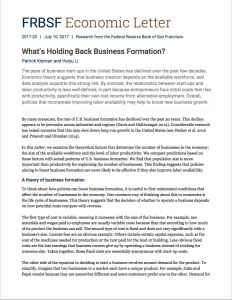Join getAbstract to access the summary!

Join getAbstract to access the summary!
Patrick Kiernan and Huiyu Li
What’s Holding Back Business Formation?
FRBSF, 2017
What's inside?
Growth in US entrepreneurial start-ups has slumped since the 1980s.
Recommendation
The long-term health of the American economy may be at risk, as the rate of new businesses created has been considerably slower in the United States than its historical norms. This fact might be a piece of the puzzle explaining sluggish GDP growth since before the Great Recession. Researcher Patrick Kiernan and economist Huiyu Li examine the root inputs of business formation and conclude that policy makers could provide opportunities to engage more robust entrepreneurial energy. getAbstract recommends this compelling report to entrepreneurs, venture capitalists and policy experts.
Summary
About the Authors
Patrick Kiernan and Huiyu Li are economists at the Federal Reserve Bank of San Francisco.

















Comment on this summary